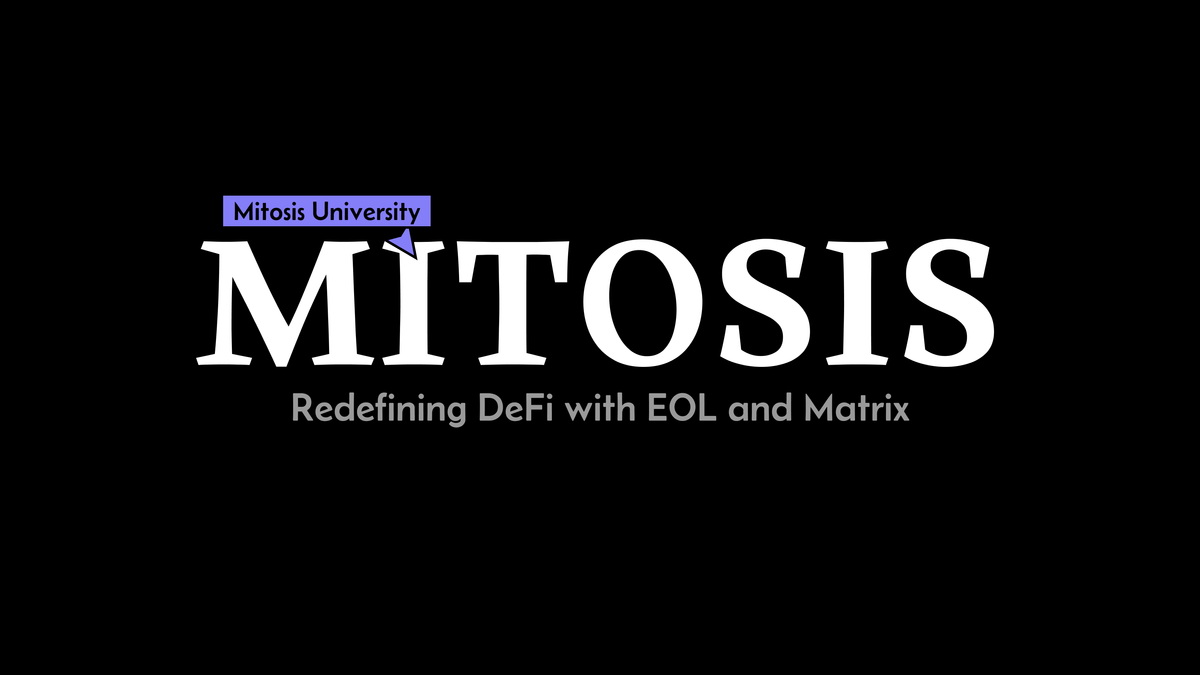Mitosis: Redefining DeFi with EOL and Matrix

Mitosis is a Layer 1 blockchain designed to revolutionize decentralized finance (DeFi) by transforming liquidity into a programmable primitive. It tackles two pervasive problems in DeFi: information asymmetry and inefficient capital allocation. These issues stem from a market where large liquidity providers (LPs) secure preferential, opaque deals with protocols, leaving retail users disadvantaged with limited visibility into yields and opportunities. Mitosis aims to level the playing field by introducing transparency and efficiency through innovative mechanisms. Let’s break this down and imagine some practical scenarios where EOL and Matrix shine.
What is Mitosis and What Problem Does it Solve?
Mitosis is a network that redefines how liquidity is managed and deployed in DeFi. At its heart, it’s a Layer 1 blockchain secured by Ethereum via EigenLayer, focused on creating a "programmable liquidity" ecosystem. This means liquidity isn’t just static capital sitting in pools it becomes a dynamic, tokenized asset that users can actively control, allocate, and optimize across multiple chains. The problems it addresses information asymmetry and inefficient capital allocation are deeply entrenched in DeFi’s current state.
Information asymmetry occurs when large LPs, often institutional players or "whales," negotiate private deals with protocols for better terms, higher yields, or exclusive incentives. Retail LPs, lacking the capital or connections, are left with suboptimal returns and little insight into these arrangements. This opacity distorts the market, favoring the well-connected over the average user. Meanwhile, inefficient capital allocation arises as liquidity gets locked in single-use pools or moves off-chain, unable to adapt to shifting opportunities across the multi-chain landscape. Protocols compete in a "Liquidity War" for Total Value Locked (TVL), but the capital often remains idle or underutilized.
Mitosis solves this by introducing Ecosystem-Owned Liquidity (EOL), where liquidity is pooled collectively under a DAO-governance model, and Matrix, a flagship product that curates premium DeFi opportunities. Through tokenized liquidity positions (miAssets), Mitosis ensures transparency, gives LPs control over allocation, and maximizes capital efficiency. It’s a shift from a fragmented, opaque system to a unified, programmable marketplace.
Scenarios Where Ecosystem-Owned Liquidity (EOL) Provides Distinct Value
EOL is Mitosis’ cornerstone innovation, allowing individual LPs to deposit assets into vaults (e.g., weETH into a Mitosis vault) and receive miAssets, which grant voting rights and yield exposure across multiple networks. The ecosystem collectively decides how this liquidity is allocated via governance, creating a transparent and efficient market. Here are some scenarios where EOL could stand out:
1. Bootstrapping Liquidity for New Protocols
Imagine a new decentralized exchange (DEX) launching on an Ethereum Layer 2 like Arbitrum. Traditionally, it would need to court large LPs or offer unsustainable incentives to attract liquidity, often draining resources or diluting fairness. With EOL, the DEX could propose its case to the Mitosis community via governance forums. LPs holding miAssets vote to allocate a portion of the pooled liquidity (say, $10 million in weETH) to the DEX’s pools, securing instant TVL in exchange for competitive, transparent yields. The DEX gets a head start without private backroom deals, and retail LPs benefit from the returns, not just the whales. This democratizes liquidity access and aligns incentives across the ecosystem.
2. Cross-Chain Yield Optimization During Market Shifts
Picture a scenario where Ethereum gas fees spike, making Layer 2 solutions like Optimism or Blast more attractive for DeFi activity. Normally, LPs would manually bridge assets to chase yields, incurring costs and delays. With EOL, a user deposits ETH into a Mitosis vault and receives miETH, and the ecosystem dynamically reallocates that liquidity to high-yield opportunities on Optimism based on governance votes reflecting market sentiment. The user earns an "omni-sourced" yield without needing to micromanage EOL handles the heavy lifting, optimizing capital across chains transparently and efficiently.
3. Countering Liquidity Drainage in Bear Markets
During a bear market, liquidity often flees to safer assets or off-chain havens, leaving protocols struggling. EOL could mitigate this by incentivizing long-term participation. For instance, a lending protocol like Aave, integrated with Mitosis, might offer enhanced rewards to attract EOL allocation. LPs deposit stablecoins into Mitosis vaults, receive miUSDC, and vote to delegate liquidity to Aave’s pools. The pooled bargaining power ensures better terms than individual LPs could negotiate, keeping capital active in DeFi rather than dormant, and stabilizing ecosystems during downturns.
Scenarios Where Matrix Provides Distinct Value
Matrix, described as Mitosis’ flagship product, curates premium DeFi opportunities by transforming liquidity positions into programmable, tokenized assets (maAssets) that earn rewards across multiple protocols. It’s about making your liquidity "work harder and smarter." Here’s where it could shine:
1. Multi-Protocol Yield Farming with Single Deposit
Consider an LP who wants exposure to yields from lending (e.g., Aave), staking (e.g., Lido), and a DEX (e.g., Uniswap) but doesn’t want the hassle of managing multiple positions. With Matrix, they deposit ETH into a Mitosis vault, receive maETH, and Matrix automatically allocates that liquidity across these protocols based on curated, high-return strategies. The LP earns aggregated rewards—say, 3% from Aave, 4% from Lido, and 2% from Uniswap, without juggling wallets or gas fees. This simplifies DeFi participation and maximizes returns, especially for retail users who lack the time or expertise for complex strategies.
2. Hedging Risks in Volatile Markets
During a volatile period, an LP might worry about impermanent loss in a DEX pool. Matrix could offer a solution by tokenizing its liquidity position (e.g., maETH-USDC) and enabling its use in a hedging strategy. The LP deposits into a Matrix vault, and the platform allocates a portion to a stablecoin lending pool on Compound for safety, while another portion earns trading fees on a DEX. If the market dips, the stablecoin yield offsets losses, and the programmable nature of maAssets allows real-time adjustments—all transparent and accessible via Matrix’s interface.
3. Developer Innovation with Composable Liquidity
A developer building a prediction market on Mitosis L1 wants to integrate liquidity for betting pools. Matrix provides pre-tokenized maAssets (e.g., maDAI) with built-in yield from EOL strategies. The developer plugs these into their smart contracts, allowing users to stake maDAI and earn both prediction market payouts and underlying DeFi yields. This composability attracts users with dual incentives and saves the developer from bootstrapping liquidity from scratch, showcasing Matrix as a launchpad for creative DeFi applications.
Why These Matter
EOL and Matrix address the core pain points of DeFi opacity and inefficiency in unique ways. EOL’s collective governance and pooled liquidity dismantle the advantage of private deals, empowering retail LPs with institutional-grade opportunities. Matrix takes it further by making liquidity a versatile, programmable tool, not just a passive resource. Together, they turn DeFi from a fragmented battleground into a collaborative, transparent ecosystem.
In practice, EOL could stabilize emerging chains (e.g., a new L2) by providing ready liquidity, while Matrix could supercharge user adoption by simplifying complex strategies. Both hinge on Mitosis’ vision of programmable liquidity, where capital isn’t just locked it’s unleashed, adaptable, and equitable. As DeFi evolves into a multi-chain reality, these tools could redefine how we think about liquidity’s role, making Mitosis a potential game-changer. What do you think, could these scenarios reshape DeFi as we know it?
You can keep in touch with MITOSIS by following:
WEBSITE || X (Formerly Twitter) || DISCORD|| DOCS


Comments ()